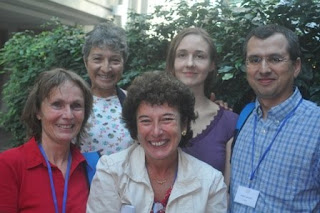Thursday, June 23, 2011
2011 International Malacology Reunion - Welcome to La Paz
The joint meetings of these two societies increased the number of contributed presentations and broaden the scientific communication between our two countries. The 2011 International Malacology Reunion will present a workshop on 'Bivalve taxonomy' by Dr. Paul Valentich.Scott (Santa Barbara Natural History Museum), and a symposium on the 'History of Malacology in Baja California' convened by Dr. Hans Bertsch (Instituto de Investigaciones Oceanológicas de la UABC). The meeting will be filled with 72 oral presentations and 67 posters dealing with molluscan ecology, systematics and phylogeny, paleontology, anthropology, aquaculture and fisheries. These presentations will be complemented by three keynote addresses, a forum discussing the CONABIO species catalog, a display of modern and fossils mollusks, and a photographic exhibit of Prehispanic shell artifacts.
Shuttles and taxis are also available at the airport. The Hotel Perla is about 20 minutes from the airport and is located at Álvaro Obregón 1570, Centro, La Paz, Baja California Sur, México, C.P. 23000. Tels. (612) 122 0777, Fax: (612) 125 5363; Toll free (CA and AZ): 1 888 242 3757, de México: 01 800 716 8799. Meeting registration for early arrivals will be from noon to 7 PM Sunday, June 26th in the lobby of hotel Perla
Additional events include:
Tour Bahía de Los Sueños, Friday, July 1 (8 am to 5 pm).
Bus for 38 seats. Ticket personal $225.00 Pesos
Bus and Lunch (8 h)
The Cactus Sanctuary of Baja California Sur, Mexico
Located in the Ejido (communal land) of El Rosario, only 45 minutes to the south of La Paz (the capital of the Mexican state of Baja California Sur), is the lonely Cactus Sanctuary (Santuario de los Cactus), in which 50 hectares of parkland have been divided into 50 distinct areas to preserve cacti and endemic plants found only in this part of the globe. Signs throughout the Cactus Sanctuary of Baja California Sur, Mexico, share information about unique plant preserve. Spectacular endemic vegetation fills the Cactus Sanctuary at the Ejido (communal land) of El Rosario.
http://www.bajachallengetours.com/santuario-del-cactus.html;
Bahía de Los Sueños
On the eastern coast of Baja California Sur is a stretch of bays and beaches that remain as secluded today as when Cortez landed here in 1535. Bahía de los Sueños (the Bay of Dreams), located 35 miles south of La Paz, is an exclusive resort community that will offer waterfront custom residences, an elite fishing club, a Tom Doak 18-hole golf course, resort hotels and spas, and the tranquility that can only come from such a natural setting.
http://www.bahiasuenos.com/
Email malacologia2011@ipn.mx and (or) efelix@ipn.mx with questions
https://www.cicimar.ipn.mx/malacologia2011/;
http://biology.fullerton.edu/wsm/;
http://www.hotelperlabaja.com/; reservaciones@hotelperlabaja.com;
For more hotels and restaurants:
http://www.vivalapaz.net/
www.turista.com.mx/hoteles-la+paz-13.html
www.zonaturistica.com/hoteles.../la-paz-baja-california-sur.html
www.visitingmexico.com.mx/
ESTEBAN FERNANDO FELIX PICO
COORDINADOR DEL COMITE DE LA REUNION INTERNACIONAL MALACOLOGIA 2011
Chairman of the Organizing Committee of WSM-SMMAC 2011 joint annual meeting
Centro Interdisciplinario de Ciencias Marinas (CICIMAR-IPN) Apdo. Postal 592
Ave. Inst. Politécnico Nacional S/N, Col. Playa Palo de Santa Rita, C.P. 23096, La Paz, B.C.S., Mexico.
PHONE: 52-612-12-25344 ext. 82428, FAX: 612-12-25322,
Friday, February 18, 2011
THE WSM IN SPAIN
There was no rain, and we weren’t on the plain! Western Society of Malacologists’ members Dr. Ángel Valdés, my wife Rosa del Carmen Campay, and I were in Vigo, on the northwest corner of Spain (approximately 42º 13' N; 8º 45' W). Located on the south side of an elongate bay, Vigo has been a major maritime port and fishing region for centuries. Due west, guarding the bay’s entrance to the Atlantic Ocean, are the two granitic islands that form the Cíes Archipelago, part of Galicia’s Atlantic Islands Land-Maritime National Park.
We were attending the Third International Workshop of Opisthobranchs (1-4 September 2010). Our dear friend and colleague Dr. Jesús S. Troncoso (Professor in the Departamento de Ecoloxía e Bioloxía Animal, of the Universidade de Vigo) was the organizing Chairman of this international event. Fellow participants were from a diversity of countries–especially Denmark, Germany, Italy, Mexico, Portugal, Russia, and the USA. Topics covered the gamut of opisthobranch (sensu lato en extremis!) research topics, from the molecular to the provincial levels of organization and interactions. Check out the website of the Workshop: http://webs.uvigo.es/3iwo10 for more details. Clicking on the links Post-Workshop and Book of Abstracts will provide numerous photographs of the participants, and the abstracts of the oral and poster presentations.
Doing science is hard work—from the field to the lab, to writing and to disseminating the results. To ease the pain, Jesús, Vice Chairman Dr. Victoriano Urgorri, and other members of the organizing committee provided numerous spectacular social events. We had a wine and cheese Mayor’s Reception at the historic “Quiñones de Leon” Municipal Museum, a guided visit to the Museo do Mar de Galicia, and enjoyed a multi-course banquet dinner at the Royal Yacht Club, which featured local marine invertebrates and fish in gourmet local sauces. We had a nudibranch observing/collecting scuba dive, and a daylong sailboat cruise to and meander on the Cíes Islands National Park. All these were in addition to the 3 days of conference sessions.
Studying mollusks has it rewards.
Hans Bertsch

Thursday, February 3, 2011
ANY IDEAS?


The gastropod illustrated here was collected from a shrimp trap off San Clemente Island at 700+ m in the early 1990's. It is associated with some fossil gastropods that all seem to have been brought into the trap by hermit crabs. Does anyone have any idea what family or genus this critter might belong to? Thanks.




.jpg)